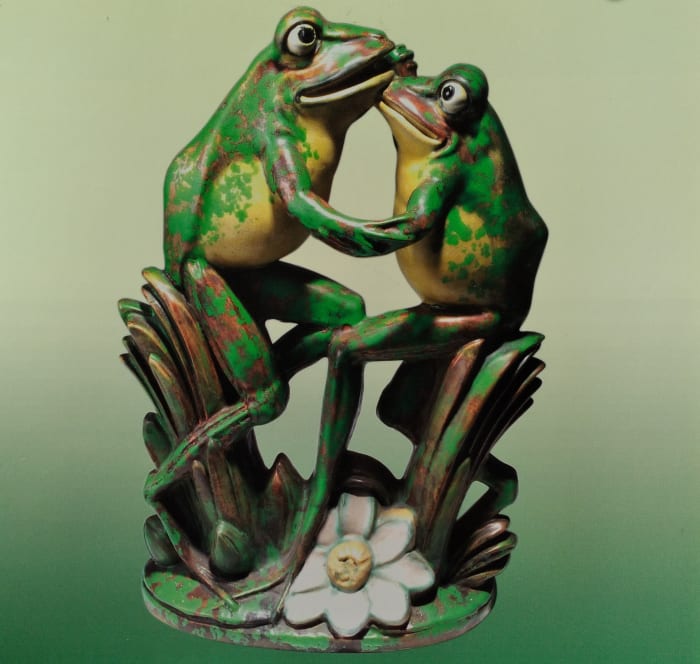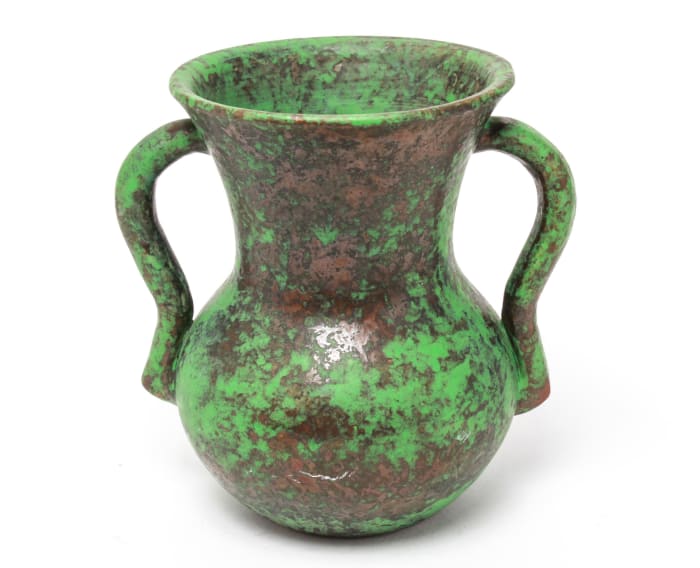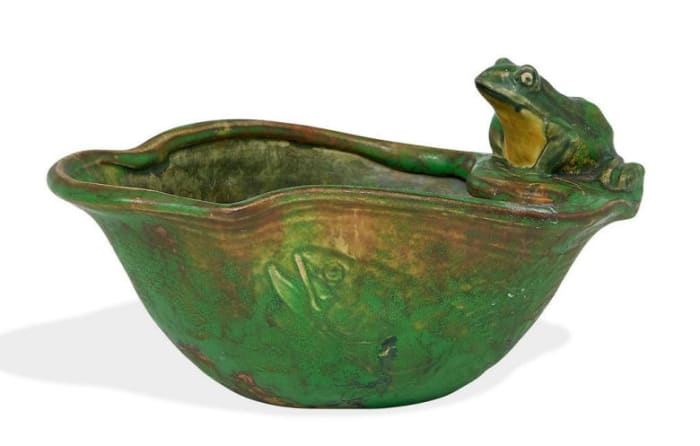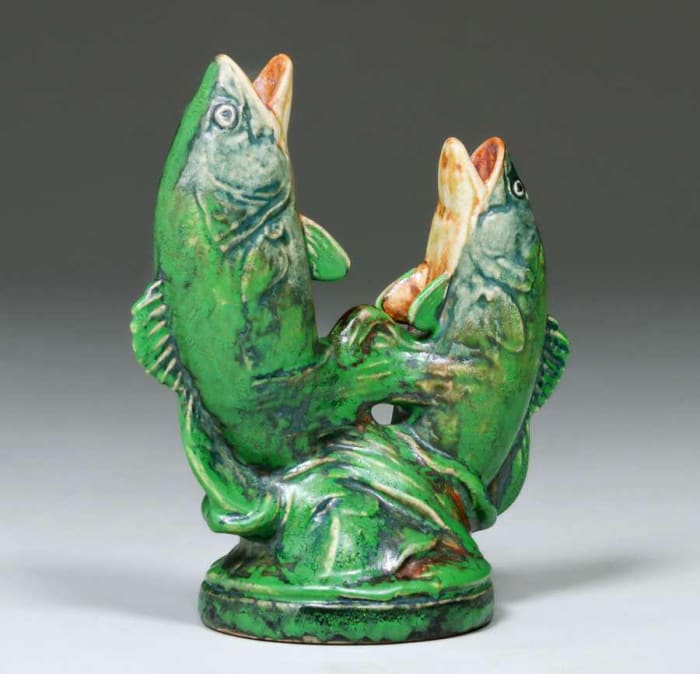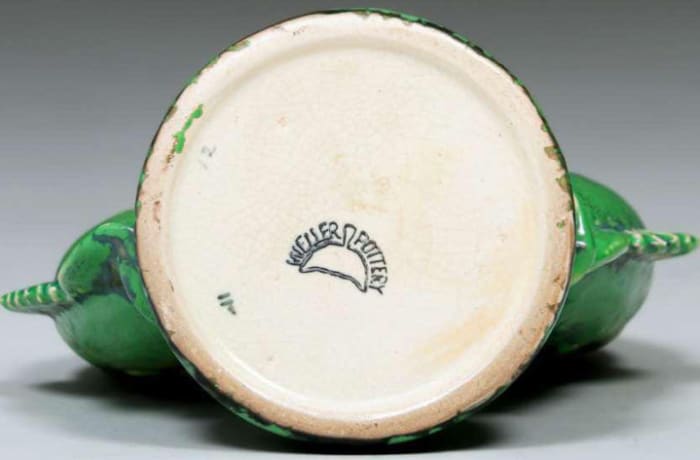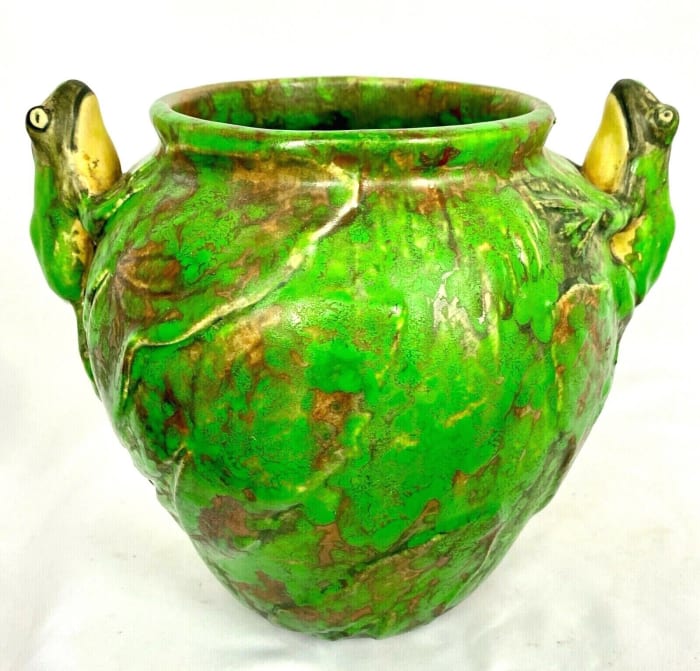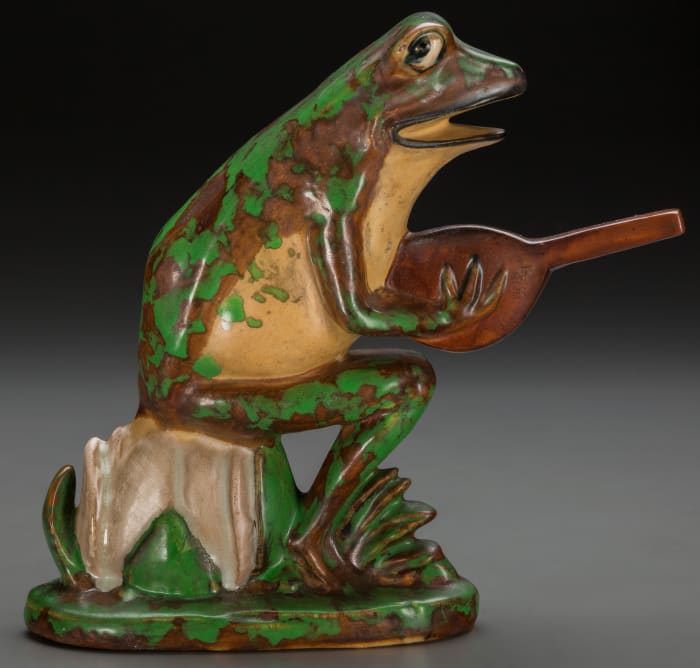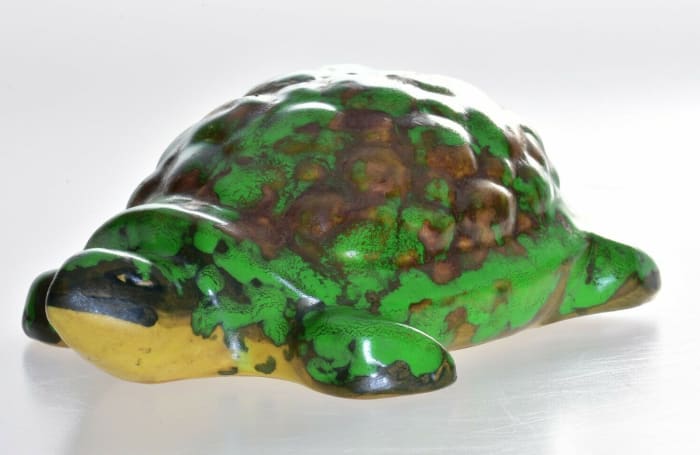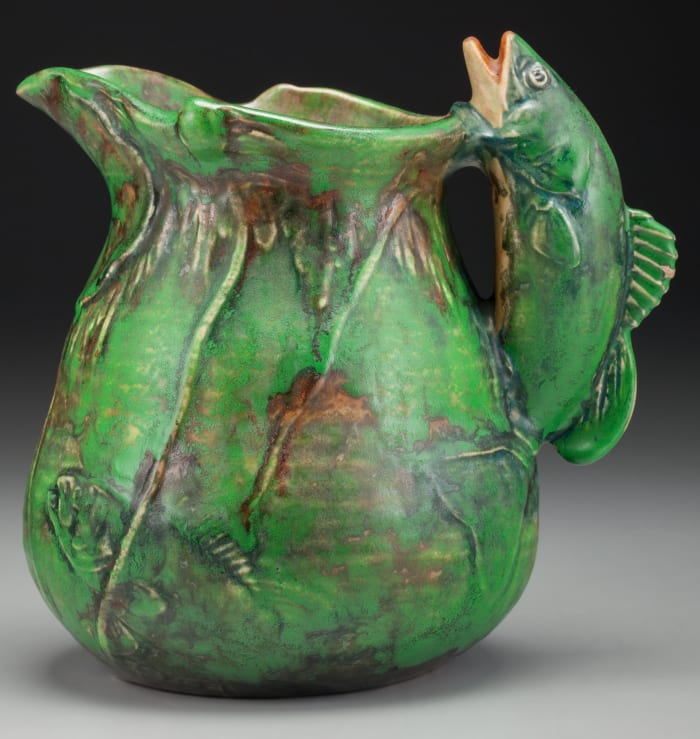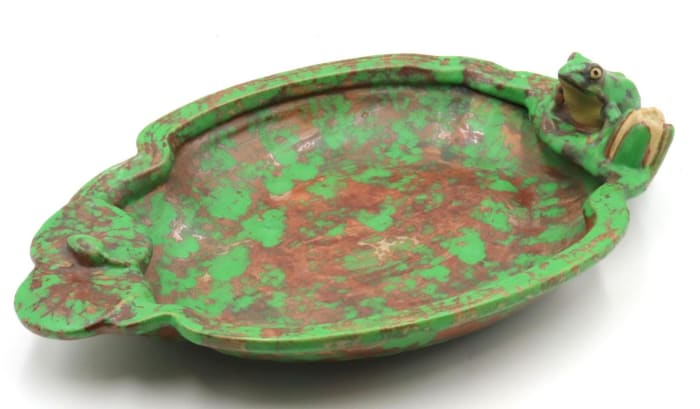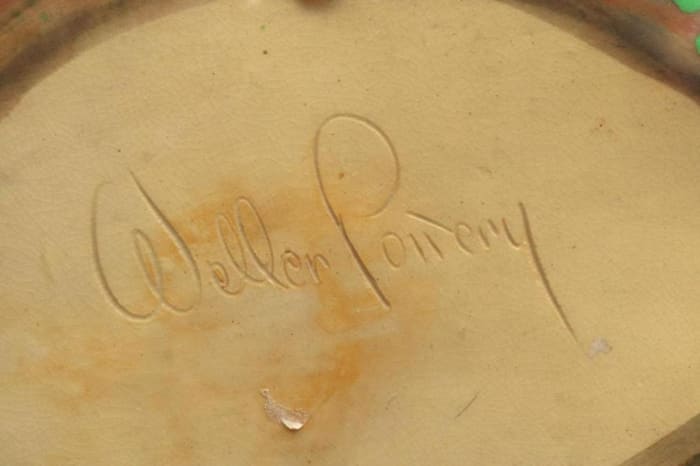When Weller Pottery developed its Coppertone line in the late 1920s, the frogs that are featured on many pieces were reportedly so popular with workers that the small ones began disappearing. More than 90 years later, these frogs are still endearing to collectors as whimsical summertime pieces that are always in season.
According to Denise Rago and David Rago, authors of Warman’s Weller Pottery, Coppertone refers to the heavily mottled green glaze created to mimic the green patina found on copper. Designed by artist Rudolph Lorber, Coppertone is one of the most well-known lines Weller produced and is easily identifiable by its bright glaze. Coincidentally, green frogs can change the color of their skin from a bright, vibrant green to a darker brown, and there can be a lot of color variation from one to the next, so it seems natural that these amphibians, the harbingers of summer, are most associated with the Coppertone line and its summer vibe.
Besides frogs, though, other pieces feature turtles and fish, but there are also pieces, such as vases, that have no summer critter attached to them.
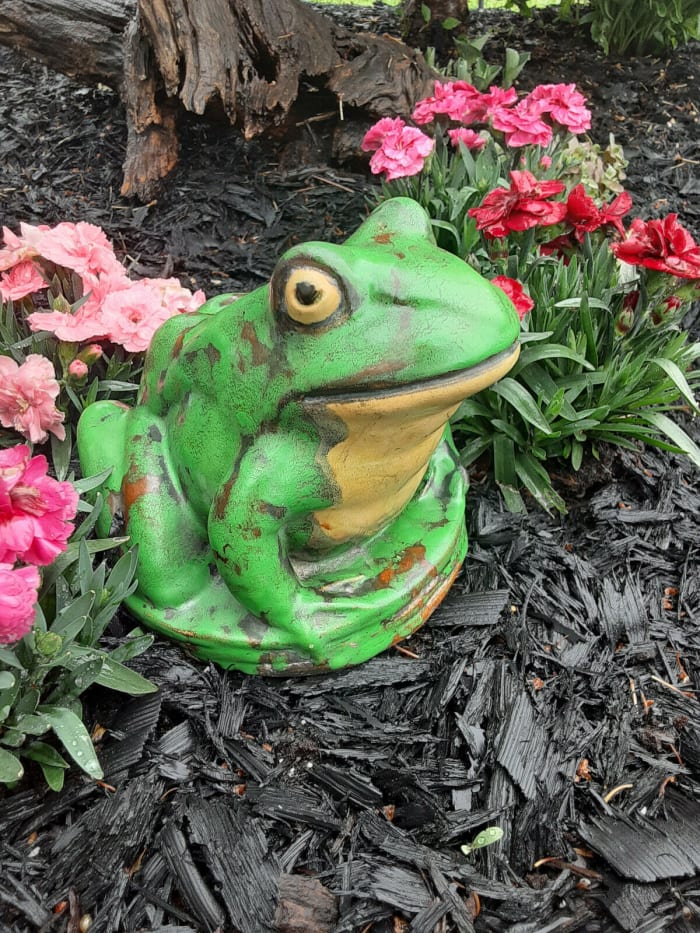
An early Coppertone frog that is around one inch larger than the later ones. It is 6″ h and about 9″ l, and sits on a 6-1/2″ base; $395.
Courtesy of eBay seller rooster731
Weller Pottery’s roots go back to when Samuel Augustus Weller of Fultonham, Ohio, launched his one-man, one-room pottery in 1872. The pioneering Weller did everything himself: He dug the clay from the soil, threw and fired his pieces, and toted them to nearby Zanesville, where he sold them door to door. The repertoire began with simple clay flower pots, cuspidors and stoneware jars.
In 1893, Weller began making his first art pottery ware, after seeing some at the Chicago World’s Fair made by competitor Lonhuda Pottery of Steubenville. Some 20 years later, Weller Pottery employed around 500 people and became the world’s largest company of the Arts and Crafts, Art Nouveau, Art Deco, and Modernism movements.
Weller’s first prominent line was the high-gloss floral Louwelsa, with other popular lines soon to follow such as Dickens Ware, inspired by author Charles Dickens, and the hand-decorated Eocean type with flowers, figures, and fruit under the glaze. Other lines of note include Knifewood, metallic Sicard and nature-adorned Baldin, Forest, and Woodcraft lines. We’ll feature these other Weller lines in a future issue of Antique Trader.
Since its inception, Coppertone has pleased and delighted gardeners, decorators, and collectors, particularly, of course, the frogs.
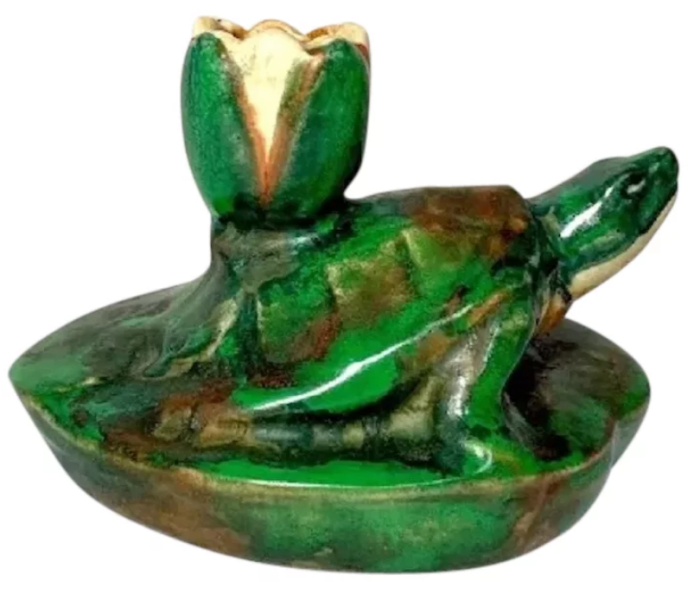
Coppertone turtle and lotus blossom candle holder; $395.
Courtesy of Clements Antiques of New Hampshire: rubylane.com/shop/clementsantiquesnh
Coppertone appears in a wide range of shapes and sizes, from an elegant water lily-embossed console bowl to ashtrays, baskets, flowerpots, large oil jars, tiles, fish pitchers, flower inserts, lamps, turtles, turtle candle holders, and the ubiquitous frogs, which can be found climbing over vases, squatting on bowls and clutching water lilies.
Beware Fake Coppertone Copies
Mark Chervenka, a renowned expert on reproductions, says that there are two modern pieces that can be confused with authentic Coppertone: a fan-shaped vase with figural frogs and lily pads and a tall solid green vase with cream-colored frogs.
At Ruby Lane’s online site, Real or Repro, which identifies fakes and reproductions, Chervenka explains the differences between the authentic pieces and the copies.
Chervenka notes that the main differences between the new and old fan-shaped vase are the size and glaze. Like most reproductions made of ceramics or pottery, new pieces are smaller than the originals. In this case, the authentic Coppertone vase is around 8 inches tall and 9 inches wide, while the copy is 6-1/2 inches tall and 8 inches wide. An authentic version of the fan vase is shown below.
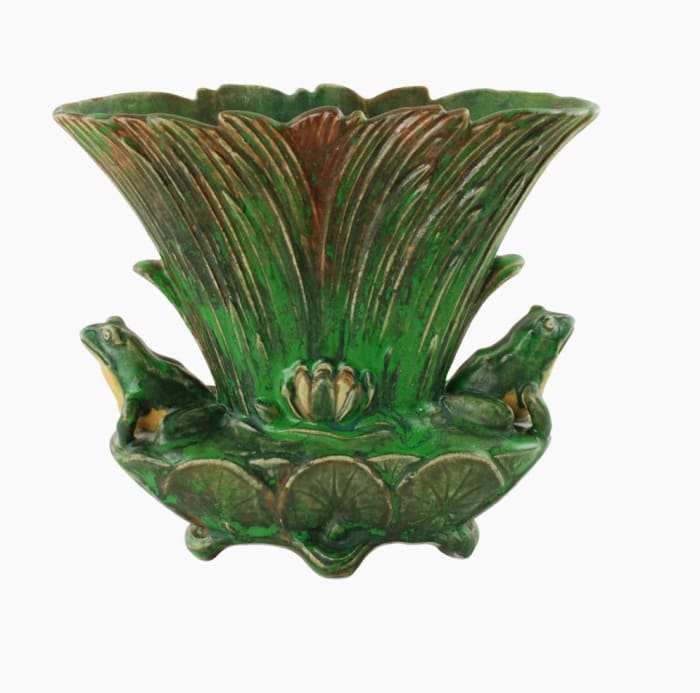
The authentic 1920s’ fan-shaped Coppertone vase, with a series of overlapping reeds and featuring two lifelike dimensional frogs that are seated at either side of the reeds. The front and back of the piece bear molded cream-colored water lily flowers located at the center, while the lower portion is decorated in overlapping lily pads. The piece is elevated on four feet; $1,250
Courtesy of Birch Hall Antiques: rubylane.com/shop/birch-hall
The glazes are also quite different, he notes. Original Coppertone is predominantly green, with patches of dark brown or bronze showing through from underneath. Glaze on the new piece is just the opposite: it is predominantly bronze/brown, with streaks and patches of green showing through from underneath.
Chervenka also notes that original pieces are not always marked. If they are, the most common marks found on authentic Coppertone are the ink stamped “half kiln” mark, “Weller Pottery” hand incised in script, or “Weller Hand Made” hand incised in script.
As for the other vase, Chervenka notes that the body and upper part of the 12-inch high piece that has been offered as vintage Weller are solid green, with no patches of bronze, and the frogs and the leaves on which they sit are cream colored. No vintage Coppertone has ever been found in the shape of the new vase, he says, and authentic Coppertone glaze is dark green with random bronze splashes.
Authentic Coppertone pieces have been selling in the past year at auction and online at Ruby Lane, eBay, Etsy and other places anywhere from $50 to $475 for vases without any frogs, turtles or fish; $150 to $900+ for frog figures and sprinklers; $120 to $1,500 for frog bowls (with some including flower frog inserts); $130-$395 for turtle candle holders and $200 to $325 for turtle figures; $225 to $1,000 for fish pieces; and $1,500 to $2,500 for rare items.
Coppertone has been consistently popular with collectors and although the values of some pieces have dropped in recent years, interest in it is still strong. From the common lily pad-shaped bowls and flower frogs to the sought after fish-handled pitcher, Coppertone has proven to be a sound addition to any collection.
You might also like:
The Religious History of Hummel Figurines


